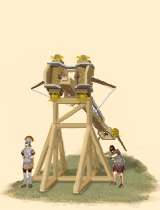Triginta Minai Ballistae (30 Minai Stone Projectors)
 |
Weapons | Defence | Mental | ||||||
|---|---|---|---|---|---|---|---|---|---|
| Primary | Secondary | Armour: | 1 | Morale: | 7 | ||||
| Type: | knife | none | Shield: | 0 | Discipline: | disciplined | |||
| Attack: | 8 | 45 | Skill: | 7 | Training: | highly_trained | |||
| Charge: | 2 | 2 | Recruitment | Other | |||||
| Lethality: | 0.04 | 1 | Soldiers: | 20 | Hit Points: | 1 | |||
| Range: | 0 | 220 | Cost: | 15000 | Mass: | 0.85 | |||
| Ammo: | 0 | 30 | Upkeep: | 3200 | |||||
| Turns: | 1 | ||||||||

Ballistae are stone throwers, mostly used during sieges to demoralize the defenders with constant bombardment, destroy the enemy battlements and drive their soldiers from the walls.
Other than the scorpiones and catapultae, ballistae are stone throwers, that mainly launch their projectiles in step angles, of mostly around 45°, so that they follow ballistic instead of flat, direct trajectories. While the small stone can used for the same purposes as the catapultae, the heavy pieces are almost exclusively limited to their role as siege artillery. They have the ability to bring down weakly built walls by themselves, but normally the ballistae will constantly bombard the enemy battlements to drive the defenders from the walls and cover the work of the primary siege engines, giant battering rams that demolish the walls with their continuous strokes.
As for most Roman missile weapons the ballistae can be loaded with incendiary ammunition to set enemy buildings and siege engines aflame, but usually well carved stone balls of the weapons calibre are used.
In action torsion engines generate a very distinct noise, that adds to the demoralising effect these machines already have on an enemy unfamiliar with artillery, when he comes under fire at greater distances than usual.
All currently used Greco Roman artillery pieces are constructed after the same basic design as two armed torsion powered engines. The torsion springs itself are made of densely packed and drilled animal sinews and human hair, they are used to store the energy until the weapon is fired. The inner ending of the two arms is directly connected to the springs, while the others are attached to a rope that runs to the carriage holding the shoot. When the weapon is loaded the operator push back the carriage, with the help of a winch to master the high forces, so that the springs are twisted. When the piece is released they will move back to their original state and transfer the stored energy to the projectile.
Historically, in the second or third quarter of the first century BC the Roman army introduced a new generation of tormentae , as the Romans called the torsion powered artillery pieces. This first genuine Roman designs, based on centuries of experience with such weapons in the Mediterranean world and some innovations of their own, proved to be a great improvement over the previously used old Greek variants. The engineers had optimized the design of the frame and the two catapult arms so that more energy could be stored in the springs and thus transferred to the projectile, giving it higher range and penetration power.
These new construction was described the first time by the architect and engineer Marcus Vitruvius Pollio, who was part of Gaius Julius Caesar engineer corps overseeing the production of his army’s tormentae and probably participated on their development itself.
In the late 2nd century BC artillery became more regularly used by roman armies to provide the urgently needed barrage fire during siege assaults as well as to defend own fortifications. In the following decades tormentae became a standard equipment of the now more permanent legions, build and maintained by their own engineers. The late fourth century military theorist Vegetius reported that finally every legion had one arrow thrower per centuria and one stone thrower per cohort and thus around 70 pieces available, but this was apparently not the case in the late Republic and early Principate when numbers were somewhat lower. Exact numbers are known for the Jewish war in 67 AD when each of Vespasian’s legions was equipped with ca. 54 tormentae.
Now Roman commanders quickly developed new tactics and made extensive use of their artillery outside traditional siege battles to assault or defend forts and field fortifications, provide fire support for amphibious landings or river crossings, keep enemy archers at distance and even in pitched battles. A development that climaxed in the creation of a truly mobile field artillery with the introduction of carroballistae and other lighter advanced designs into the imperial army around 100 AD.